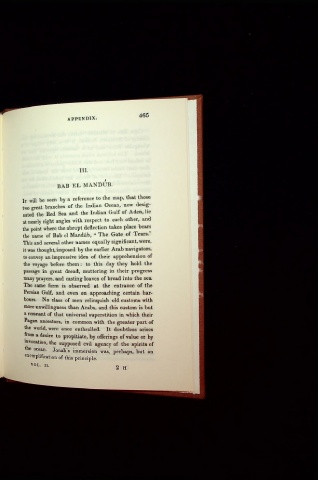Page 500 - Travels in Arabia (Vol 2)_Neat
P. 500
464 APPENDIX. APPENDIX.
“ In many respects the plants are the same as those of
the peninsula of Sinai,—Fagonia cretica, and another
species, Zygophyllum simplex, Stcitice cicicularis, As
tragalus hamosus, Tphiona scalrci, the plant called
Bovea by Decaisne, and several species of Egyptian
Labiatce, forming some of its most remarkable features. III.
It also comprehends one of our common dead nettles
(Lamium amplexicaule). BAB EL MANDUB.
On the other hand, the Lithospermwn vestitum of
India, Asphodelus fistulosus—from which the Aspho- It will be seen by a reference to the map, that those m
of the Indian Ocean, now desig-
delus clavatus of the Doab is not different, and which two great branches
the Red Sea and the Indian Gulf of Aden, lie
therefore extends from Malaga to India—Acanthodium nated
at nearly right angles with respect to each other, and
spicatum, and Cotula cinerea, sufficiently indicate the
approach of the Flora to a form more tropical than that the point where the abrupt deflection takes place bears
the name of Bab el Mandiib, “ The Gate of Tears.”
of Egypt or Palestine.
“ Besides these things, I find specimens of the Inula This and several other names equally significant, were,
odor a and Convolvulus spinosus of Yemen, both of it was thought, imposed by the earlier Arab navigators,
which are unknown to the northward; and there is to convey an impressive idea of their apprehension of
species of bramble, probably the Rubus fruticosus of the voyage before them : to this day they hold the is
Forskahl, which although very incomplete, is to all ap- passage in great dread, muttering in their progress 1
pearance undescribed. many prayers, and casting loaves of bread into the sea.
“ The collection contains various other species, but as The same form is observed at the entrance of the
they do not bear upon any points of general interest, I Persian Gulf, and even on approaching certain har-
forbear to enumerate them.”—Geographical Journal hours. No class of men relinquish old customs with
more unwillingness than Arabs, and this custom is but
a remnant of that universal superstition in which their
Pagan ancestors, in common with the greater part of
the world, were once enthralled. It doubtless arises
from a desire to propitiate, by offerings of value or by
Invocation, the
supposed evil agency of the spirits of
the

